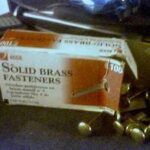Having been a screenwriting contest reader for a number of years, many, many scripts have passed before my eyes. As any reader will tell you, we can flip through a script and tell you if it’s going to be bad in about 2 seconds. Other problems come to light as we start to actually read. Here’s a list of things to avoid if you want a reader to actually pay attention to the story.
1. Big, Solid Blocks Of Text In Action Paragraphs.
Each action paragraph should be a new camera angle. Every time you look at something new as you visualize the film, make a new paragraph.
2. Camera Directions.
You don’t need to say CAMERA ON or PAN TO for the simple reason stated above. If each new paragraph is a new camera angle, it’s obvious that the camera should be on whatever is in the paragraph.
As for the PAN TO or other movements, that’s not your job as the writer. If you’re going to direct the script yourself, go for all the camera angles you want. If you’re submitting the story to anyone who uses readers like me, drop them. They’re not necessary if you use your paragraphs effectively and they’re disruptive to the story’s flow.
3. Big, Solid Blocks Of Text In Dialogue Paragraphs.
Movies are a visual medium. As such, what the characters say is a lot less interesting than what they do. At least it’s supposed to be. Television is more talky, but you still can’t get away with a character talking for page after page after page. A good rule of thumb is 5 lines max. Less, if possible.
Think about conversations you’ve had in real life. How bored do you get when somebody goes on and on and on and on…
4. Pages Of Conversation Uninterrupted By Action.
Just as you don’t want one character talking all the time, you don’t even want two or more characters bantering back and forth for extended periods either. This is what’s known as talking heads. It gets really monotonous to watch characters talk with nothing else going on in the scene around them.
5. Wasting Space On The Mundane.
Scripts are written in a very tight space. You have a lot to do – developing characters, advancing the plot, etc. – in a limited amount of time. Don’t waste any of it with characters saying hello or goodbye or brushing their teeth or anything else that’s not crucial to the plot.**
6. Over-Describing The Action.
As mentioned earlier, action paragraphs need to be broken down into shots. Taking this a bit further, you have no more than 5 lines to fully describe the shot. Less, if possible. Choose your words carefully and mention only what is essential to the story.
For example, imagine you’re describing a police precinct. It’s much more essential to mention the cop with a sword on his hip than the ones with their standard, police issued guns. The key is to focus on the extraordinary.
7. Non-Specific Scene Headings.
EXT. LONDON – DAY is too broad of a location for any action to take place. It’s not specific enough to tell the reader anything about the character. Nor does it give any hint to the Director as to where he should set up his camera. Does he need Parliament in the background? Or should he be filming a seedy alley? At the script stage, it’s up to you to make this clear.
8. Over-Specific Scene Headings.
INT. JACK’S HOUSE THAT HIS AUNT IDA LEFT HIM IN HER WILL BUT HER KIDS TRIED TO CON HIM OUT OF IT – NIGHT
Nothing tells a reader faster that a writer doesn’t have a clue about scriptwriting than a slug line like this.
The entire scene heading should fit on one line. All that’s needed from the example above is: INT. JACK’S HOUSE – NIGHT or INT. JACK’S HOUSE – KITCHEN – NIGHT
The rest of the information is extraneous in terms of the scene heading’s purpose which is to tell your crew if you are filming outside or inside, where you’re filming and what time of day. The other information can only be revealed as the story moves forward if it’s in the script at all.
9. Action Paragraphs In All CAPS.
This is formatting for a multi camera sitcoms and has no place in film scripts. All caps tells the reader that you didn’t bother to learn proper format or that you just don’t care about the screenplay. Neither option will make us think very highly of you.
10. Scenes That Go On For Years.
Just like there are limits to the size of action and dialogue paragraphs, there are limits to scene length. You have about 2 pages, tops, to do what needs to be done. Enter the scene late and leave it early.
Bonuses: Make sure you introduce all your characters in CAPS the first time they appear.
Always introduce a character in an action paragraph before he or she has any dialogue.
Of course there will always be exceptions to the “rules” as they are not set in stone. The trick to getting away with breaking a rule is to break it for a purpose. And at your own risk.
**For example, it’s okay for a character to say “hello” if it’s something extraordinary for that character to do or defines him in some way. It’s not okay if you just can’t think of anything else for him to say at that point.
If you’re ever in doubt about what formatting permits or doesn’t, think of it in terms of the people who will be using your script to do their jobs.
Can the electricians tell which lights and filters they need for the scene? Can your casting director easily pick out the roles they need to cast? Can your property master figure out which props to acquire? If questions like these have easy answers and it doesn’t interfere with the flow of the story, chances are you have a pretty solid script!
And there you have it. Screenplay format from a reader’s perspective.
Happy writing!!





